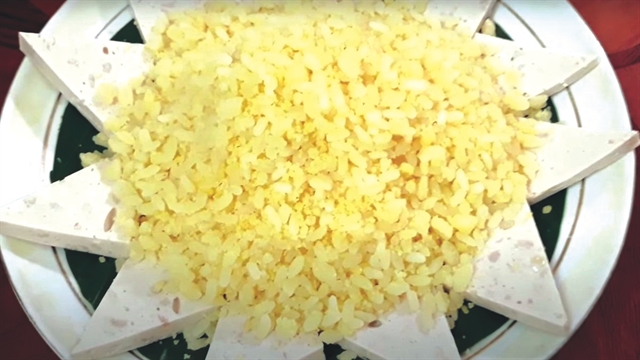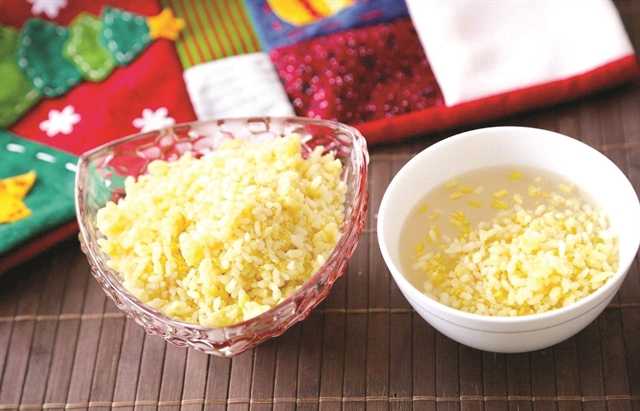[ad_1]
Thu Hiền
In Vietnamese cuisine, steamed sticky rice is very popular among all ethnic groups, as rice has been planted nationwide for thousands of years.
There are many steamed sticky rice dishes, such as xôi xéo (sticky rice with mung bean and fried onion), xôi gấc (sticky rice with spiny gourd), xôi lạc (sticky rice with peanuts) and xôi đậu xanh (sticky rice with mung bean).
Xôi vò (sticky rice with crushed mung bean), is among the most popular across the country, available in cities and rural areas, from street stalls to solemn meals as offerings to ancestors.

Sticky rice is soaked in clean water for eight hours while mung bean is soaked for four hours. The rice is dried before salt is added.
A secret to making good xôi vò is letting the ingredients dry before steaming, so the seeds do not stick on to one another, as in other kinds of steamed sticky rice dishes.
The steamed mung bean is then ground into powder. It takes some 15 minutes to get a well-steamed bean. It should be ground into a smooth powder.
The rice is then mixed with half of the bean powder, together with some oil.
“We use oil to make the rice shiny and prevent the rice seed from sticking to one another,” said chef Lê Thanh Miến, from Hà Nội’s Hoàn Kiếm Vocational Centre.
“We crush the bean powder so that it sticks well to the rice, which is the reason why the dish is called xôi vò (sticky rice with crushed bean),” he said.

The mixture is steamed for about 20 minutes. When the rice is soft, it is well-done.
“To get the rice dry, you should from time to time wipe off water on the saucepan’s cover,” Miến said.
Then the mixture should be mixed with the other half of the bean powder, before being steamed for another five minutes.
The dish is ready to serve, once some fried onion, salted shredded pork or lean pork paste is added.
Xôi vò can be served with chè hoa cau (sweetened mung bean and cassava gruel) as a dessert.
According to housewife Trịnh Mai Lan from HCM City, southern people will add some essence of turmeric to mix with the sticky rice, so that the dish has an attractive yellow colour.
“You can pound some turmeric, mix with some water and take the water to mix with the well-soaked rice,” she said.
The southern people also put some coconut cream to put in the sticky rice while steaming to add more flavour to the dish, Lan said.
Pandan leaves can be added into the steamed rice for some more flavour, too, she said.
When the rice is well steamed, some sugar can be added into the dish to suit southerners’ taste.
“The dish in the north will taste salty while that in the south tastes sweeter,” Miến noted.
Dish suits all purposes
Sweetened lotus seed gruel can be processed simply with cassava/arrowroot powder, sugar, lotus seeds and mung bean.

Mung bean is soaked in water for some three hours before being let dry and mixed with some salt. It is then steamed well.
Some cassava/arrowroot powder is mixed with water. Suggested recipes will include 150g powder and 150ml water. Boil one litre of water with some 200g of sugar, then slowly add the cassava/arrowroot mixture into the saucepan. Stir well until the mixture gets thick and clear. Then, add the mung bean into the mixture.
Miến advised adding some coconut cream into the gruel to add a more fatty and fragrant flavour.
“You should wait for the gruel to cool before storing it in the fridge,” he said. “Add steamed sticky rice on top while serving.”
The soft gruel goes well with the sticky rice that is eaten as dessert or a snack, as well as breakfast for generations. VNS

[ad_2]
Source link
